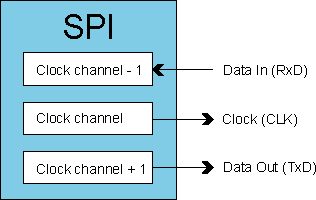Serial Peripheral Interface (SPI) eTPU Function
The SPI function uses three eTPU channels to form a bi-directional, synchronous serial port that can be used to communicate with a wide variety of devices. It can be used to add serial capabilities to a device without a serial port, or to add further serial port(s) to a device that already has a hardware-synchronous port. The function requires no host CPU's intervention once the function has been initialized and a request for data transmission has been made. One eTPU channel is configured to function as the clock and the other two are configured to function as serial transmitter (TxD, or 'data out') and serial receiver (RxD, or 'data in'). The eTPU SPI function provides similar functionality to the TPU3 SIOP function. Peripheral Chip Select (PCS) functionality is not provided by the eTPU SPI function but could be easily implemented using GPIO eTPU function.

The main features of the SPI function are as follows:
- Programmable baud rate period over a 23-bit range of TCR1 or TCR2 counts
- Selection of msb or lsb first shift direction
- Variable transfer size from 1 to 24 bits
- Programmable clock polarity
- Master mode only
For full description refer to AN2847.